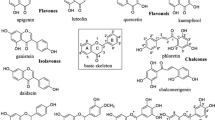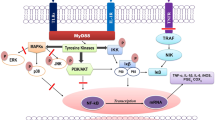Abstract.
Mast cells are multipotent effector cells of the immune system. They are able to induce and enhance angiogenesis via multiple pathways. (—)-Epigallocatechin-3-gallate (EGCG), a major component of green tea and a putative chemopreventive agent, was reported to inhibit tumor invasion and angiogenesis, processes that are essential for tumor growth and metastasis. Using the human mast cell line HMC-1 and commercial cDNA macroarrays, we evaluated the effect of EGCG on the expression of angiogenesis-related genes. Our data show that among other effects, EGCG treatment reduces expression of two integrins (α5 and β3) and a chemokine (MCP1), resulting in a lower adhesion of mast cells associated with a decreased potential to produce signals eliciting monocyte recruitment. These effects on gene expression levels are functionally validated by showing inhibitory effects in adhesion, aggregation, migration and recruitment assays.
Similar content being viewed by others
Author information
Authors and Affiliations
Corresponding author
Additional information
Received 20 July 2007; accepted 8 August 2007
Rights and permissions
About this article
Cite this article
Melgarejo, E., Medina, M.A., Sánchez-Jiménez, F. et al. (—)-Epigallocatechin-3-gallate interferes with mast cell adhesiveness, migration and its potential to recruit monocytes. Cell. Mol. Life Sci. 64, 2690 (2007). https://doi.org/10.1007/s00018-007-7331-4
Published:
DOI: https://doi.org/10.1007/s00018-007-7331-4




